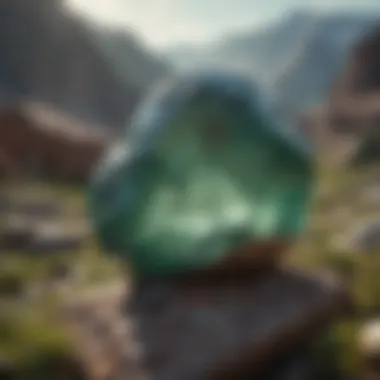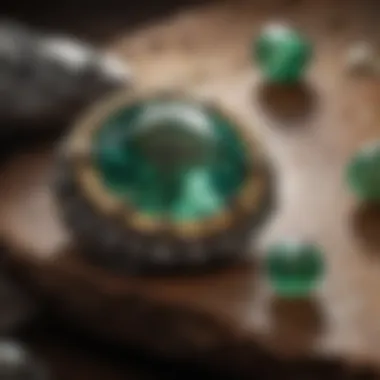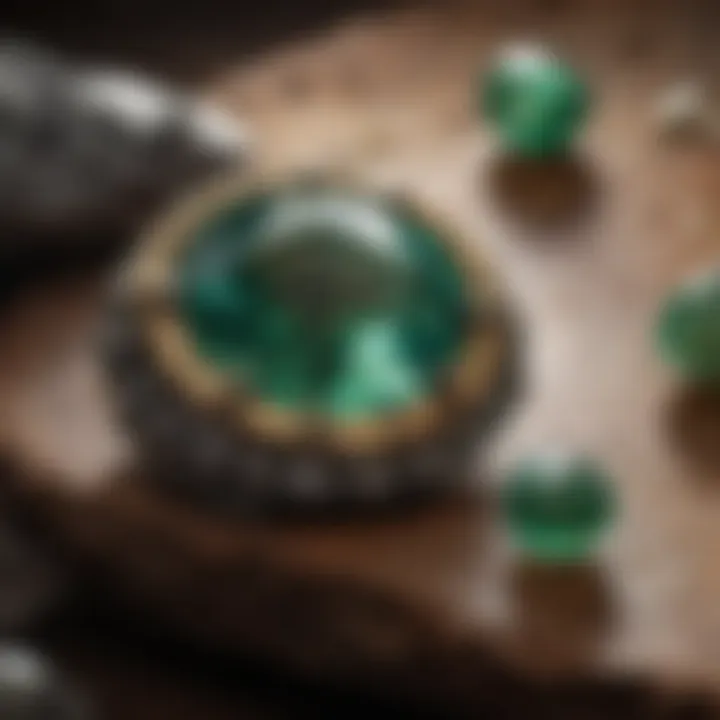Exploring the World of Green Minerals and Gemstones


Intro
The beauty of green minerals and gemstones has captivated humanity for centuries. Their vibrant hues, ranging from the rich emerald of jade to the soft verdant shades of serpentine, create a natural palette that is both appealing and diverse. Whether appreciated for their aesthetic qualities or valued for their unique geological properties, green stones have a fascinating story to tell about our planet and its history.
As we delve into the subject of these remarkable specimens, it's essential to recognize their significance beyond mere decoration. Green minerals and gemstones hold cultural weight, play a role in traditional practices, and carry environmental implications that impact both the present and future. For rock and fossil collectors, understanding these elements enhances the appreciation of their collections while fostering a deeper connection to the Earth.
In this guide, we will explore the historical underpinnings of green minerals and gemstones, identify various types through classification, and evaluate their modern applications. We will also shed light on sourcing practices that influence how these treasures reach the hands of collectors, shedding insight into the ethical considerations surrounding them.
History and Origins
Overview of Collectibles, Rocks, and Fossils
Green minerals have a storied past, intertwined with human history and cultural heritage. From antiquity to the modern era, gemstones have been utilized for adornment and symbolism. They often represent status, power, or spiritual beliefs, particularly in ancient civilizations where materials derived from the Earth were believed to hold metaphysical properties.
Take jade, for instance—this stone has been cherished in Chinese culture for thousands of years. Not only was it used to create tools and ornaments, but it also symbolized virtue and purity, accentuating its significant role in the society. Many collectors delight in acquiring jade artifacts due to their historical richness and craftmanship.
Historical Significance and Cultural Impact
Over the ages, green stones have transcended their physical beauty to serve as cultural icons. Malachite—known for its distinct banded patterns—was used in Ancient Egypt as a protective talisman and often ground into powder for cosmetic use. Similarly, green tourmaline has been linked to healing properties, where people believed it could ward off negative energy.
Additionally, the fascination with emerald dates back to Mesoamerican civilizations, where it was considered as precious as gold. Today, emeralds continue to capture the imaginations of collectors globally, often representing luxury and prestige.
"Green gemstones are not just admired for their color, but their stories; each stone holds the whispers of its origin."
Identification and Classification
Understanding the different types of green minerals and gemstones aids collectors in steering clear of counterfeits and inferior stones. Knowing what to look for in terms of color, clarity, and origins will ensure a more satisfying collection.
Guide to Identifying Rocks and Fossils
When acquiring green minerals, collectors should focus on several key characteristics to identify genuine specimens:
- Color: The hue can range from deep forest greens to soft pastel tones. The saturation and consistency of color can indicate quality.
- Clarity and Transparency: Look for any inclusions or cloudiness, which are often signs of lower quality.
- Luster: Each mineral has a distinct shine, from glassy to greasy to pearly finish. Understanding luster can help distinguish between similar stones.
- Hardness: Utilizing the Mohs scale, testing the hardness can confirm a specimen's nature; for instance, emeralds rank around 7.5 to 8.
Common Types and Variations
Some popular green gemstones and minerals include:
- Emerald: A variety of beryl, known for its vibrant green color and rarity.
- Jade: Comprising mainly nephrite and jadeite, each with its unique properties.
- Malachite: Recognizable by its striking banded green patterns.
- Peridot: This gemstone forms under high temperatures and is often favored for its light green shade.
- Green Tourmaline: Valued for its discrepancy in color depth and crystal structure.
By familiarizing oneself with these characteristics and gemstones, collectors can navigate the diverse marketplace of green stones with greater confidence.
Prelims to Green Minerals and Gemstones
Green minerals and gemstones hold a unique position in both the earth sciences and the world of collectors. They are not just visually appealing; these stones are steeped in complex histories, geological marvels and cultural significance. Their vibrant hues draw numerous enthusiasts, from jewelers to geologists, deeply engaging a variety of audiences.
Throughout this article, we’ll dig deeper into what makes these green varieties not only captivating but also vital to understanding broader ecological and cultural narratives. The significance of green colors in minerals isn't just a surface-level observation. The very minerals that produce these colors can illuminate the geological processes at play within Earth itself.
We will also emphasize the benefits of understanding these minerals, highlighting how their roles extend beyond aesthetic appreciation to include environmental considerations and the moral implications of sourcing. As collectors and aficionados, recognizing the nuance in each mineral can deepen appreciation and insight into this captivating world.
Defining Green Minerals
Green minerals are those that display prominent green colors due to various factors, including the presence of specific chemical elements and structural variations. Chrome or iron typically plays key roles in imparting these shades, affecting everything from appearance to value. For instance, the striking emerald owes its vivid green to trace amounts of chromium and vanadium, while green garnets may derive their hues from iron impurities in their unique crystal structures.
To categorize them effectively, we could look at specific traits such as crystalline forms, chemical composition, and their geological environments. Green minerals come in many forms, each exhibiting unique characteristics that are both visually striking and scientifically interesting. Details such as fluorescence, streak color, and luster can clearly differentiate one mineral from another.
Significance of Color in Minerals
The role of color in minerals serves as a significant indicator of their identity, formation environment, and even potential uses. For instance:
- Color Variations: Different minerals exhibit variations in color based on their chemical makeup. A gemstone's color can thus give essential clues about its geographic origin, such as the vivid greens of Tsavorite sourced from Tanzania, or the softer hues of jadeite found in Myanmar.
- Cultural Symbolism: Green has historically been associated with fertility, life, and renewal across many cultures. This symbolism can add layers of value to gemstones and minerals as they are often sought for their metaphysical properties or cultural significance.
- Market Trends: It’s important to note that trends in mineral collecting can shift the demand for certain colors. The rise in popularity of environmentally friendly practices has also kicked up interest in green gemstones generally considered ethical alternatives.
"Color can tell a story—a tale of history and environment containing treasures waiting to be discovered."
Understanding the significance of color not only enriches the knowledge for collectors but also opens windows to broader conversations about the minerals' roles in society, sustainability, and even fashion. With this framework in mind, let’s delve into the types of green minerals that have captured the imagination of collectors worldwide.
Types of Green Minerals
Understanding the various types of green minerals is crucial for anyone looking to appreciate or invest in these unique natural treasures. The varying hues, structures, and applications of green minerals not only define their aesthetic appeal but also their geological significance and role in culture. By delving into these minerals, enthusiasts can grasp why they hold such a prominent place in jewelry, art, and even industry.
In the exploration of green minerals, we highlight key aspects such as geological formations, cultural importance, and their valuation, which collectively underscore their multifaceted nature.
Emerald
Geological Formation
Emeralds are born in the crucible of geological processes that stretch over millennia. Formed primarily in metamorphosed limestone under intense heat and pressure, these deep green gemstones often house trace amounts of chromium and vanadium that give them their distinctive color. The presence of these elements creates a lush hue that draws the eye.
The formation dynamic of emeralds is essential because it impacts their rarity and desirability. Unlike other gemstones, the specific geological environments where emeralds are found, such as Colombia and Zambia, contribute significantly to their overall quality. The combination of geological factors plays a pivotal role in their aesthetic appeal and, subsequently, their market value.
Cultural Importance
Emeralds have held a place of reverence across various cultures. From ancient Egyptians who believed emeralds symbolized fertility, to the Aztecs who deemed them sacred, the blue-green glow of emeralds captivates across time and geographies. Their historical narratives provide layers of meaning, enhancing their allure.
This cultural emphasis not only enriches the stories behind these gems but also elevates their perceived value in the market. The multidimensional aspect of emeralds makes them not just ornamental, but culturally significant artifacts that connect modern wearers with the folklore of the past.
Valuation
The valuation of emeralds is multifaceted, influenced by the gemstone's clarity, color, and origin. While many gemstones are assessed solely on size or carat weight, emeralds bring in additional factors, like the presence of inclusions, often referred to as the gem’s “jardin,” or garden in French.
This unique characteristic can both enhance and detract from its value; some collectors seek out emeralds with inclusions that tell a story. Thus, valuing emeralds is not simply a quantitative venture—it involves understanding the underlying mystique and historical anecdotes that accompany each piece.
Jade
Genesis and Characteristics
Jade comes in two primary types: jadeite and nephrite. These variations stem from different minerals and geological processes. Jadeite boasts a striking range of colors, with vivid greens being among the most sought after.


Geologically, jadeite forms under high pressure and temperature, typically found in subduction zones—areas where one tectonic plate moves under another, creating unique chemical environments. The specific genesis of jade provides insight into its durability and hue, making it not only an enduring gemstone but also a symbol of strength and resilience.
Historical Uses
Historically, jade served diverse functions. For the Chinese, jade was not just a stone; it was imbued with spiritual and cultural significance. Artifacts carved from jade have been unearthed in ancient tombs, illustrating their use in rituals and as symbols of status.
The historical richness of jade fosters a sense of connection for collectors and enthusiasts, linking them to ancestral traditions. However, the broad range of jade applications also means it can be misrepresented in modern markets, where authenticity is paramount.
Modern Appreciation
In recent years, jade has experienced a renaissance in fashion and design, appreciated for its deep cultural roots as well as its aesthetic qualities. Designers incorporate jade into contemporary jewelry, emphasizing both its beauty and symbolism.
This modern appreciation ensures that jade remains relevant, yet it also raises questions about sourcing and authenticity in an age where replicas can mislead buyers. Collectors must navigate these challenges while fostering appreciation for genuine jade.
Peridot
Origin and Properties
Peridot is formed from volcanic activity and is primarily found in the Earth’s mantle. Its vibrant green color comes from iron, and it typically has a distinct clarity. Peridot is one of the few gemstones that come in only one color, which can vary from yellowish-green in lighter specimens to deep olive in darker ones.
Understanding the origins of peridot deepens one’s appreciation for its properties. Its unique formation method endows it with vibrancy and a certain lightness, differentiating it from denser gemstones. Yet, while beautiful, its softer nature can lead to wear over time, making care essential for collectors.
Symbolism and Folklore
Known as the “evening emerald,” peridot has been associated with light and strength throughout history. Various cultures symbolize it as a stone of prosperity and happiness, often perceived as protective against evil spirits.
This rich symbolism enhances its appeal as a gemstone, but also places a certain pressure on its sellers and marketers to maintain the narratives that accompany it. For avid collectors, understanding the folklore may contribute to personal attachment and investment in peridot.
Market Trends
The market for peridot has remained relatively stable, though it did see a spike in interest due to its unique qualities and captivating color. Environmental awareness and a growing interest in sustainable practices mean that consumers increasingly seek ethically sourced stones.
This shift can positively influence pricing and demand, allowing peridot to remain competitive in an ever-evolving market. Yet, gem enthusiasts should be cautious of trends, as they ebb and flow significantly over short periods.
Tourmaline (Green Varieties)
Identifying Features
Green tourmaline, known as verdelite, possesses a remarkable range of shades from dark evergreen to lighter hues. The way light interacts with the internal structure allows for a unique pleochroism, showing different colors when viewed from different angles.
These identifying features are essential for collectors to recognize authentic green tourmaline. This stone’s captivating nature means it often garners attention in jewelry but can sometimes be misclassified, leading to potential pitfalls for novice buyers.
Geological Sources
Green tourmaline has several geological sources, with notable locations in Brazil and Africa. Each source can yield tourmalines of differing qualities and unique characteristics. Brazilian tourmalines are known for their vibrant hues, while African varieties might display a distinct transparency.
Identifying the geological source can not only enhance the value but also informs buyers about the history and journey of the stone. Having knowledge of these sources can lead to more informed decisions in purchasing and collecting.
Use in Jewelry
In the jewelry world, green tourmaline stands out for its stunning color and versatility. Designers appreciate its durability along with its unique shades, which often complement other gemstones in multi-stone pieces.
Moreover, the variations in shade allow for creativity in design that appeals to a broad range of tastes. However, greater demand has also led to higher prices and a competitive market, pushing buyers to thoroughly research before investing.
Emerging Green Gemstones
Emerging green gemstones are gaining recognition not just for their beauty, but also for their unique stories and market potential. These stones offer a fresh perspective in a world flooded with well-known gems. Their rarity, specificity, and cultural ties make them both alluring and significant in the larger narrative of gemology.
Tsavorite
Unique Traits
Tsavorite, a variety of garnet, boasts a vivid green hue that captivates gem enthusiasts and designers alike. Its rich color stems from chromium and vanadium, which give it an intense saturation that can rival even the finest emeralds. This vibrant coloring is a key characteristic of Tsavorite, providing a visual appeal that is hard to miss.
This gemstone is also known for its exceptional brilliance and clarity, often having a greater brilliance than other green stones due to its high refractive index. Collectors regard it as a beneficial choice because it combines beauty with relative affordability compared to more established gems, making it an appealing option for both personal collections and jewelry design.
The unique feature of Tsavorite is that it is usually found in a striking shade reminiscent of spring leaves. The challenge here is its less common availability in the market, which can make sourcing it more tricky.
Mining Practices
The mining practices for Tsavorite today are largely focused on sustainability and community benefits. The primary source of Tsavorite is in Tanzania, where artisanal mining methods are employed alongside local cooperatives. This characteristic is vital as it impacts the local economy positively, creating jobs and promoting ethical mining practices.
However, artisanal mining can often come with its drawbacks, such as higher environmental risks and less stringent regulatory oversight in some areas. Hence, while these practices aim for positive contributions, they require careful management to ensure the ecological footprint is minimal.
Rare Availability
Tsavorite is rarer compared to many green gemstones, primarily due to its limited geographical sources. The mines are in remote areas that are not as easy to access, which adds to its allure. Its rarity is a significant characteristic, making it highly sought after by collectors and gem lovers alike.
The scarcity of Tsavorite is a double-edged sword: on one hand, its limited availability can drive up demand and price, making it a treasured piece in collections; on the other hand, it can be frustrating for buyers who find it difficult to locate. This unique feature underscores Tsavorite's position as a beneficial choice for those seeking something distinct and exceptional.
Green Sapphire
Distinguishing Features
Green sapphire is another emerging gemstone that captures attention with its depth of color and durability. Unlike its blue counterpart, green sapphire exhibits a range of colors, from light mint greys to deep forest hues. This variety in hues is a defining feature that makes it a versatile option for jewelry designers.
The durability of green sapphire is commendable as it ranks 9 on the Mohs scale of hardness. Accordingly, this makes it a popular choice for daily-wear jewelry, ensuring that it maintains its aesthetic appeal even under regular use.
The unique feature of green sapphires is their color zoning, which can create a fascinating play of colors within a single stone. This characteristic adds layers of interest, elevating the stone’s desirability in the market.
Market Demand
The market demand for green sapphires has seen a notable rise, fueled by consumer penchant for unique alternatives to traditional gemstones. Their relative affordability compared to other well-known stones also makes them an attractive option. Moreover, green sapphires are emerging as a favored choice among millennial buyers who are leaning toward distinctive and distinctive choices when it comes to engagement rings and other fine jewelry items.
One key characteristic about market demand is that it has been influenced by social media platforms showcasing these gemstones, making them more accessible and relevant in current trends. For rock collectors, this has resulted in an increase in interest in sourcing these precious stones.
Investment Potential
The investment potential of green sapphires can be categorized as promising. As the demand increases, so does their valuation, particularly for higher-quality stones. In contrast to more mainstream gemstones, green sapphires can represent a less volatile investment, particularly when choosing stones with exceptional clarity and color saturation.


Another key characteristic is that they often retain value well over time, making them wise choices for those looking to build a substantial collection. However, as with all investments, potential buyers should educate themselves about market fluctuations and trends.
Emerging green gemstones hold the potential to revitalize interest in lesser-known varieties, blending beauty, rarity, and sustainability into gems that are, quite frankly, worthy of attention in any serious collector's inventory.
Properties of Green Gemstones
Understanding the properties of green gemstones is crucial for anyone interested in this elaborate world. Knowing their physical and optical traits helps both enthusiasts and collectors appreciate these stones fully. These characteristics not only provide insight into their aesthetic appeal but also into their durability and how they can be integrated into different applications, from jewelry making to alternative healing practices.
Physical Characteristics
Hardness and Durability
Hardness and durability are fundamental traits when evaluating gemstones. The Mohs scale, which ranks minerals based on scratch resistance, gives a clear picture of how robust a stone is. For instance, emeralds rank around 7.5 to 8 on this scale, meaning they can endure reasonable wear yet may be prone to chipping if mishandled. This hardness makes them a popular choice for jewelry, as they hold up well to daily use.
One unique feature of hardness in green gemstones is that some, like jade, possess a toughness that allows them to resist breaking under stress. This toughness, unlike mere hardness, is crucial for gemstones that are used in delicate pieces or everyday jewelry. The benefit of durable stones is that they can be enjoyed without constant worry of damage, appealing greatly to consumers seeking longevity in their investments.
Color Variations
Color variations in green gemstones add to their charm and individualism. Stones like tourmaline can showcase a range of green hues, depending on the trace elements present during formation. This variability allows for a rich palette that caters to different tastes. Moreover, collectors often seek specific shades—for example, the deep green of imperial jade versus the lighter hues of peridot.
A noteworthy aspect of color variation is that it can drastically affect value. The uniqueness of a particular color shade can make the stone more desirable and, thus, more expensive. However, it may sometimes also lead to confusion, especially when multiple gemstones are mistaken for each other due to similar colors. This aspect can be advantageous for those who appreciate variety and want to curate a diverse collection.
Luster and Transparency
The luster and transparency of green gemstones can significantly impact their visual appeal. Luster refers to how a gemstone reflects light. Some, like jadeite, may exhibit a waxy luster, giving them a soft glow; others, such as emeralds, boast a more vitreous shine. The transparency varies greatly, too—while some gemstones, like green garnet, can be quite transparent, others like jade may be opaque.
The unique feature here is that luster can change under different lighting conditions, often enhancing the stone's desirability. For instance, an emerald's luster may be even more pronounced under natural sunlight, drawing attention to its vibrancy. However, high transparency can also mean vulnerabilities, as more visible inclusions often affect a gemstone's clarity and perceived value. Therefore, understanding how luster and transparency work together is vital for making informed purchasing decisions.
Optical Properties
Birefringence
Birefringence is a fascinating optical property that defines how light interacts with certain gemstones. This phenomenon occurs when a gemstone has two refractive indices, causing light to split into two rays as it enters. Materials such as tourmaline display this characteristic, leading to unique visual effects. Wearing a birefringent gemstone can create shifts in color based on the perspective of the viewer, which ultimately adds to its allure.
This unique optical trait can be a beneficial aspect for collectors who seek stones that offer more than just aesthetic pleasure—these stones tell a story through their interactions with light. However, the complexity of birefringence can also complicate matters regarding authenticity and value, as it requires specialized knowledge to appreciate properly.
Pleochroism
Pleochroism refers to the way certain gemstones can appear different colors when viewed from different angles. Greenish-blue tourmaline exemplifies this trait beautifully, displaying subtle shifts in hue that can mesmerize any observer. For collectors, this unique color play can translate into added value and desirability, as stones exhibiting strong pleochroism are often rarer.
While this property enhances a stone's character, it does require a trained eye, especially in distinguishing between genuine pleochroism and color zoning which can sometimes confuse the untrained spirit. Therefore, understanding pleochroism is beneficial not just for valuation but for experience in gemstone collection.
Fluorescence
Fluorescence is another captivating characteristic that can be observed in various green gemstones. Some stones, under ultraviolet light, produce a bright glow that can range from white to vibrant colors. A common example is the green diamond, which can exhibit a striking fluorescence when subjected to a blacklight, captivating collectors.
This unique feature can elevate a gemstone’s allure, creating a compelling case for purchase based on not just how the stone appears under regular light but its transformation under special lighting conditions. However, it bears noting that not all gemstones exhibit this trait, and those that do can occasionally carry a stigma within some circles, as fluorescence may affect how a gem is priced in the market.
"Properties of green gemstones are not merely a matter of aesthetics; they compromise a complex interplay of physical and optical attributes that enrich their value and significance in various contexts."
By exploring these properties in depth, we can better appreciate their role in the world of geology and jewelry making, aiding both collectors and enthusiasts alike.
Historical Context of Green Minerals
The rich historical backdrop of green minerals and gemstones cannot be overlooked in understanding their cultural significance and lasting allure. These minerals have been revered, collected, and utilized by various civilizations for centuries. Their stories are intertwined with art, religion, and trade, making them valuable not just physically but also symbolically. As we delve into the past, we uncover how these gems have shaped human experiences and aspirations, contributing to their modern relevance.
Ancient Civilizations and Green Gemstones
Use in Artifacts
Throughout history, green gemstones have been employed in artifacts, ranging from ceremonial objects to decorative items. For instance, ancient Egyptians carved exquisite scarabs from green stones like jade and mineralized forms of serpentine, integrating them into jewelry and burials. This
significance reflects a deep connection between these minerals and beliefs about the afterlife. The fact that these artifacts have survived the ravages of time speaks volumes about the durability and attractiveness of green stones, making them an intriguing focal point for dealers and collectors alike. The unique feature of specific artifacts is their craftsmanship, which showcases not just the material's beauty but also the artistic abilities of the era.
Cultural Symbolism
Green stones often carried profound cultural symbolism, representing life, fertility, and renewal. Stone such as emerald or jade were treasured in various ancient civilizations. The Chinese linked jade to immortality, while the Mayans believed in its power to attract wealth and prosperity. This systematic connection of symbolism with green minerals creates a multidimensional narrative that still feeds into contemporary beliefs and practices.
In addition, the strong cultural traits associated with these stones add layers of meaning that contribute to their appeal in modern contexts. The challenge lies in reconciling modern interpretations with ancient meanings, a task that reveals both the adaptability of these beliefs and their stability over centuries.
Trade Routes
Trade routes played a significant role in the spread of knowledge and appreciation for green minerals. The Silk Road, for instance, acted as a conduit for not just physical goods but cultural interchange. Green gemstones, sought after for their rarity, traversed vast distances, from hills of Colombia harbored emeralds to the mines of Myanmar and further into Europe. It highlights the economic value assigned to these stones over history. Moreover, this intertwining has led to the fusion of craftsmanship styles; varied techniques were exchanged and adapted, resulting in unique designs that reflect collective traditions.
However, while these historical trade connections expand the significance of these minerals, they also expose the complexities of value perception across cultures. What’s favored in one region may remain obscure in another, therefore broadening the conversation around green gemstones.
Modern Relevance
Fashion and Industry Trends
Green gemstones are not just shrinking artifacts of past civilizations; they find their way into contemporary fashion, with designers keen on showcasing their vibrant hues and unique properties. They adorn both high-end jewelry and everyday pieces, making them desirable for audiences ranging from collectors to casual buyers. The current trend leaning towards individuality has propelled these stones into the spotlight, making them crucial in discussions around the aesthetics of modern jewelry. Still, challenges persist as consumers grapple with authenticity and quality amid growing demand.
Sustainability Concerns
As the jewelry industry evolves, so do its impacts on the environment. Sustainable practices are increasingly adopted in response to ecological concerns tied to mining green gemstones. Critically, manufacturers and designers are pressured to rethink sourcing methods to ensure minimal environmental degradation. Although this shift towards sustainability is commendable, it raises questions about accountability and practices across varying regions and their effectiveness in curbing the adverse impacts of extraction.
Ethical Sourcing
Finally, ethical sourcing is profoundly relevant in today’s marketplace. Consumers are more discerning than ever, seeking not only beauty but a story behind the stones. This scrutiny has prompted manufacturers to align with ethically sound practices, ensuring gemstones are sourced responsibly.Coupled with increasing awareness, this shift has fostered an environment that encourages transparency and accountability, thus enriching the narrative around both ancient and modern uses of these minerals.
This historical exploration of green minerals bridges the gap between the past and the present, emphasizing their enduring significance as they adapt to contemporary values and practices. As jewelers and collectors navigate these waters, understanding the rich backdrop of these stones offers invaluable insights into their present-day allure.
Green Gemstones in Contemporary Applications
Green gemstones have woven themselves into the fabric of modern society in remarkable ways. From their roles in trendy jewelry to their applications in alternative medicine, these natural treasures are gaining momentum. As we deepen our understanding of the contemporary relevance of green gemstones, it’s evident they play a multifaceted role in contemporary culture and industry.
Jewelry Industry
Design Innovations


In recent years, design innovations within the jewelry industry have transformed the way green gemstones are incorporated into fashion. Designers are merging traditional craftsmanship with modern technology, pushing boundaries to create striking pieces. One of the key characteristics of this movement is the emphasis on personalized designs, which have become increasingly popular. This focus on customization allows consumers to express their individuality through unique jewelry pieces. An unique feature of this evolution is the use of advanced techniques, such as 3D printing, which minimizes waste and allows for intricate designs that were previously impossible.
The advantages of these innovations include better sustainability practices and heightened creativity in design. However, they come with the disadvantage of potentially raising costs. This leads to a conversation about accessibility, as some consumers may feel alienated by higher price points.
Popularity in Modern Fashion
Green gemstones are carving a niche in modern fashion trends, reflecting a shift towards vibrant, nature-inspired aesthetics. As fashion becomes more eco-conscious, the popularity of these gems keeps rising. Notably, the key characteristic of this trend lies in the growing preference for sustainable and ethically sourced materials. Consumers are increasingly drawn to makers who prioritize environment-friendly practices, which boosts the covetability of pieces featuring green gemstones.
A unique feature of green gemstones in fashion today is their versatility; they can be paired effortlessly with various styles, from casual to formal. The advantages of this popularity are significant, as they encourage eco-friendly choices in sourcing. However, not all consumers may fully understand the sustainability dialogue surrounding these gemstones, presenting an ongoing challenge in the industry.
Consumer Awareness
Consumer awareness has emerged as a crucial element in the conversation surrounding green gemstones. With a well-informed public, there is a notable demand for transparency in sourcing practices and the environmental impact of gem mining. This awareness fosters a culture of responsible consumption, allowing individuals to purchase not only aesthetically pleasing items but also ethically sourced ones. One key characteristic of consumer awareness is the insistence on education around the products people buy.
The unique feature of this grassroots movement is the integration of knowledge-sharing platforms, such as workshops or online forums, which educate consumers about gemstone properties and sourcing tactics. The advantage here is a more conscientious consumer base, pushing businesses toward responsible practices. On the other hand, this could disadvantage smaller producers lacking resources to meet consumer demands for transparency.
Alternative Healing Practices
Crystal Healing Claims
Crystal healing has found its place in discussions about alternative therapy, and green gemstones are often at the forefront. This practice capitalizes on the belief that these stones possess unique energies that can promote physical and emotional well-being. A standout characteristic of this aspect is how it combines ancient tradition with modern wellness culture, appealing to those seeking holistic or natural remedies.
An unique feature of crystal healing is the specific claims associated with different green stones, like how emeralds are thought to enhance intuition. The benefits of this anecdotal evidence paint a picture of hopeful possibilities, although skepticism often surrounds such claims. Ultimately, those who find value in these practices often embrace them wholeheartedly.
Holistic Uses
The holistic uses of green gemstones extend further than just crystal healing; they can also be incorporated into various wellness practices like meditation and aromatherapy. This overlapping field emphasizes the spiritual and emotional connections that individuals can cultivate with their gemstones. A key characteristic of these uses is their flexibility; users may incorporate green gemstones in diverse practices, fostering a deeper personal connection with the stones.
One unique feature is how these practices are often tied to environmental consciousness. As people seek a connection with nature in their healing journeys, green gemstones provide a perfect link. The advantage is that holistic approaches can promote wellness without chemicals or pharmaceuticals, yet this can lead to downsides including a lack of scientific backing for these practices.
Cultural Perspectives
Cultural perspectives on green gemstones reveal a fascinating tapestry of beliefs and traditions around the world. Various cultures have ascribed meanings and uses to these stones through generations, creating a rich narrative steeped in history. The key characteristic of this diversity highlights how green gemstones are often viewed as symbols of healing, prosperity, or protection.
A unique feature here is how cultural lens can lead to varying interpretations of stones like jade or malachite. These differing perspectives strengthen community ties and cultural identity. On the downside, the commercialization and globalization of these beliefs may dilute their significance, leading to misunderstandings or cultural appropriation.
Green gemstones serve not just as adornments; they represent cultural significance and personal journey, merging beauty with meaning in the modern age.
Environmental Considerations
The discussion around green minerals and gemstones naturally extends beyond their aesthetic allure or geological properties; it touches the pulse of our environment. Understanding the implications of mining and the necessary efforts toward sustainability is vital. Green minerals, with their unique hues that embody nature, reflect a deeper connection to the earth, inherently forcing us to examine how our actions impact their existence, distribution, and ethical valuation.
Mining Impact
Ecological Concerns
Mining for green minerals often leads to the disruption of ecosystems. When miners dig into the earth, they might unintentionally destroy habitats and displace wildlife. This aspect should not be taken lightly; the unique characteristic of ecological concerns in mining is that it poses a long-term threat to biodiversity. Current mining practices sometimes overlook the interconnectedness of flora and fauna, and this can lead to an imbalance in local ecosystems. It's often the case that people think only of the minerals, without recognizing the delicate balance that sustains those very treasures. Hence, it is essential for this article to draw attention to these ecological impacts and stress the importance of a balanced approach that safeguards our natural world while allowing for the pursuit of minerals.
Regulatory Framework
A robust regulatory framework is imperative in mitigating the adverse effects of mining. Governments implement laws to ensure that mining companies follow environmental standards. One key characteristic of these regulations is how they dictate the actions of miners, making them accountable for harm caused to the environment. The presence of diligent regulations can be seen as a beneficial aspect in this tricky balance between resource extraction and environmental protection. However, in some regions, enforcement can be lax, leading to questionable practices that further erode trust in the industry. The unique feature here lies in the varying degrees of regulatory strictness across different jurisdictions, exposing some mining operations to a lack of oversight while highlighting the need for unified standards.
Community Relations
The relationship between mining companies and local communities has a significant bearing on environmental considerations. Companies often benefit from having positive interactions with residents; however, friction can arise when communities feel disenfranchised or overlooked. An important characteristic of community relations is the potential for shared benefits. Firms that engage local populations in decision-making processes might innovate pathways for sustainable practices. Yet, the challenge remains: if economic incentives are prioritized over social responsibility, the trust eroded can lead to adverse outcomes for both parties. In the long run, fostering good community relations proves advantageous, ensuring that social ecosystems are as preserved as the natural ones.
Sustainable Practices
Recycling and Upcycling
Recycling and upcycling have garnered attention as essential practices to lessen the carbon footprint associated with mining. Recycling gemstones or utilizing residues from mining can reduce the need for fresh extraction, which now offers an environmentally conscious choice. One unique feature of recycling is its dual benefit—not just conserving resources, but also reducing waste. It allows the beauty of previous gems to be reintroduced into the market, thus presenting a financially attractive option for consumers as well.
Responsible Consumer Choices
Consumer choices hold significant weight in the sustainable dialogue. As informed buyers, rock and fossil collectors are in a position to demand transparency and ethical sourcing from companies. The key characteristic of responsible consumer choices is their direct influence on market trends. When consumers prioritize sustainability, companies might adjust their practices accordingly. Yet, not all buyers may be aware of the impact of their choices, leading to a potential disconnect between intention and action. For this article, it’s crucial to underscore that a culture of mindful consumption can push the industry toward greater accountability.
Innovative Mining Technologies
Innovative mining technologies are reshaping how minerals are extracted with a focus on minimizing environmental impacts. Advanced techniques like remote sensing and eco-friendly extraction methods offer promising benefits. One distinguishing aspect of these technologies is their potential to reduce waste and lower the ecological footprint of mining operations. However, while technology progresses, challenges remain regarding costs and accessibility. Thus, the health of the environment and the mining industry remains a delicate balancing act, one where innovation might play a pivotal role but cannot single-handedly solve long-standing issues.
"A thorough understanding of environmental considerations in gemology challenges both collectors and those in the industry to re-evaluate the footprint of their passion. We owe it to the earth to make choices that ensure that its treasures remain not just for this generation, but for many to come."
Ultimately, the environmental considerations surrounding green minerals and gemstones not only emphasizes their beauty but also the profound responsibility that comes with valuing these natural wonders.
Culmination and Future Directions
As we wrap up our exploration of green minerals and gemstones, it becomes evident that these natural wonders hold deep significance across various domains. Understanding their properties, historical context, and modern applications not only enriches our appreciation but also informs responsible practices for future generations. This conclusion centers on vital insights and projections that highlight the continued relevance of these materials in today's world.
Summarizing Key Insights
The journey through green gemstones illustrates their multi-faceted importance in areas like culture, science, and the environment. Key takeaways include:
- Diverse Properties: Each green mineral exhibits distinct physical and optical characteristics, shaping its use and valuation in the market.
- Cultural Heritage: These minerals have been cherished across civilizations, symbolizing power, status, and spirituality.
- Mining Ethics: Awareness of the environmental and social implications of gemstone extraction is on the rise, pushing for sustainable practices.
The resonance of these insights moves beyond mere fascination. As conscious citizens and collectors, there’s a shared responsibility to preserve the beauty of these stones while minimizing our ecological footprint.
Potential Developments
Emerging Trends
A noticeable shift in consumer preferences is steering the jewelry industry toward more sustainable options. The increasing popularity of lab-grown gemstones represents a significant trend, driven by:
- Cost-effectiveness: Lab-created stones often come at a fraction of the cost of their mined counterparts, appealing to budget-conscious buyers.
- Ethical sourcing: With rising awareness around conflict minerals, many buyers prefer goods that do not involve environmental degradation or exploitation.
- Innovation in design: Designers are capitalizing on unique aesthetics offered by lab-grown stones, creating compelling pieces that challenge traditional notions of value.
These traits make lab-grown options not just a trend but a sustainable shift in how consumers view and select gemstones.
Collective Responsibility
Collective responsibility is a cornerstone of future directions in the gem and mineral trade. This includes:
- Consumer Awareness: As collectors and buyers become more informed about the origins of their stones, there is a growing demand for transparency in sourcing.
- Industry Standards: Jewelers and miners are increasingly held accountable for ethical practices, fostering a culture of sustainability and transparency.
- Community Impact: Supporting local communities where mining occurs can lead to improved living conditions and economic development, ensuring that the benefits of gemstone extraction are felt locally.
Having a shared responsibility means that all stakeholders—collectors, retailers, and miners—play a part in nurturing the environment and enhancing the lives of those involved in the gemstone market.
In essence, the future of green minerals and gemstones hinges on a fusion of tradition and innovation. Embracing sustainable practices will not only preserve these treasures for posterity but also ensure their vibrant role in culture, art, and commerce.



